Key takeaways:
- Selective mutism is a complex anxiety disorder rooted in fear, causing children to struggle with communication in specific social situations while remaining verbal in comfortable environments.
- Visual aids, such as storyboards and emotion cards, effectively bridge the communication gap for children with selective mutism, enhancing understanding and reducing anxiety.
- Engaging children in the creation of visuals fosters empowerment, encourages expression, and can lead to meaningful conversations about their feelings and experiences.
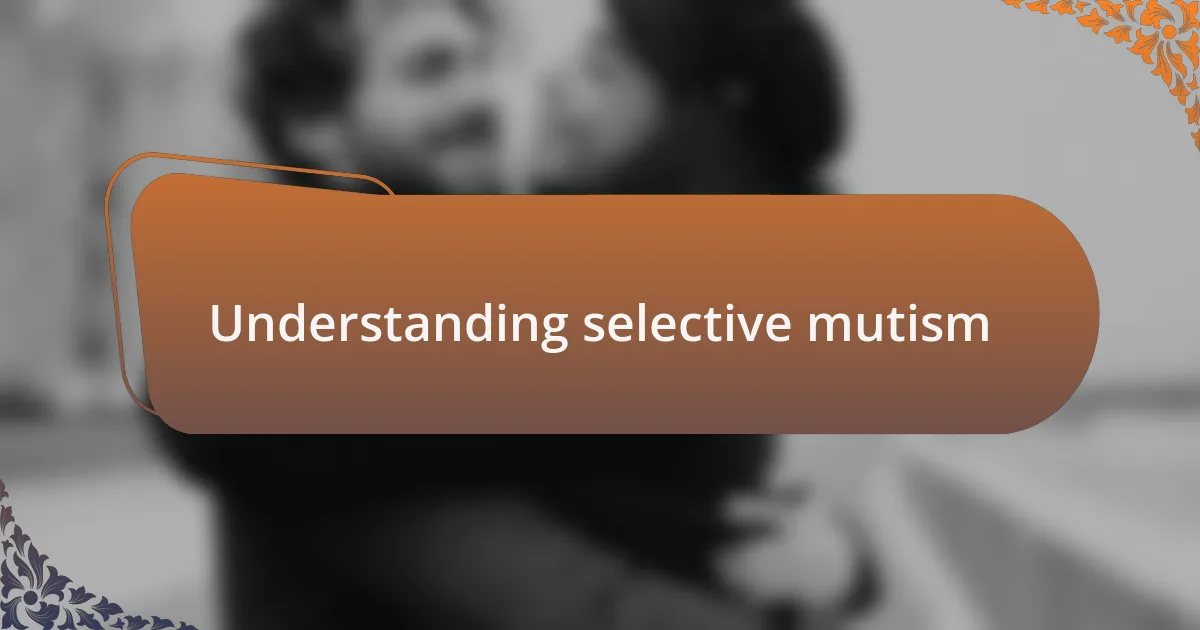
Understanding selective mutism
Selective mutism is a complex anxiety disorder, primarily affecting children, characterized by an inability to speak in specific social situations, despite speaking comfortably in other settings. I remember meeting a young girl who was vibrant and chatty at home but would freeze at school. This stark contrast often leads people to misunderstand the condition as mere shyness, but it’s much deeper than that.
One of the most heartbreaking aspects of selective mutism is seeing a child silently struggling in situations where they wish to communicate but feel overwhelmed by anxiety. Have you ever felt so nervous that words just wouldn’t come out? That’s what these children experience daily, leading to feelings of frustration and isolation. It’s crucial to recognize that their silence isn’t a choice; it’s a symptom of their internal battle.
Understanding selective mutism also involves appreciating its roots in fear and anxiety. Each child’s journey is unique, shaped by their personal experiences and environments. Sometimes, I think about how vital a supportive community is for these children—can you imagine feeling trapped in your own silence? Only with understanding and intervention can we help them find their voice in a world that feels daunting.
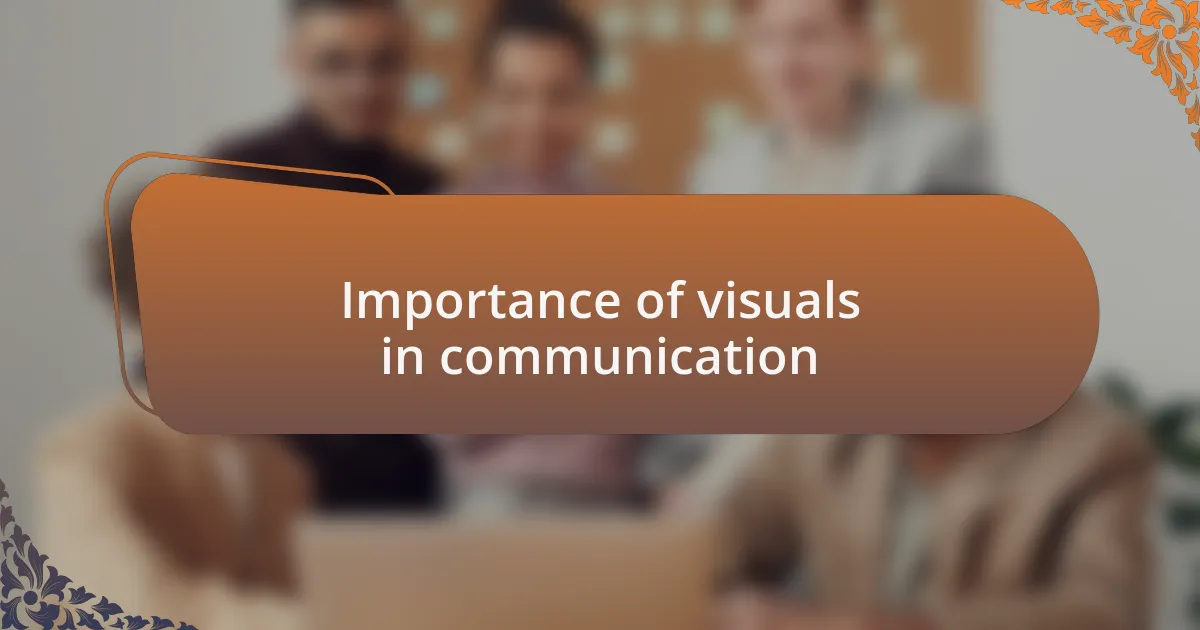
Importance of visuals in communication
Visually engaging content can bridge the gap between silence and communication, particularly for children with selective mutism. I’ve seen how illustrations or infographics can tell a story that words sometimes fail to convey. Imagine a young child pointing to pictures rather than speaking; it gives them a voice in a world that feels too loud for their quiet spirit.
When I recall working with kids struggling to articulate their thoughts, I remember how the right visuals would spark their interest and encourage interaction. For instance, using images of familiar characters or comforting scenarios opened up a dialogue—one that might not have happened otherwise. Isn’t it fascinating how a simple image can evoke feelings and prompt expression?
Visuals not only complement spoken language but also enhance understanding and retention of information. When complex ideas are presented visually, they become more accessible, especially for those who may find traditional verbal explanations overwhelming. Have you ever tried to grasp a tricky concept and found that a diagram made everything click into place? The power of visuals in communication, especially for children facing challenges like selective mutism, is profound; it creates a pathway to understanding that can lead to empowerment.
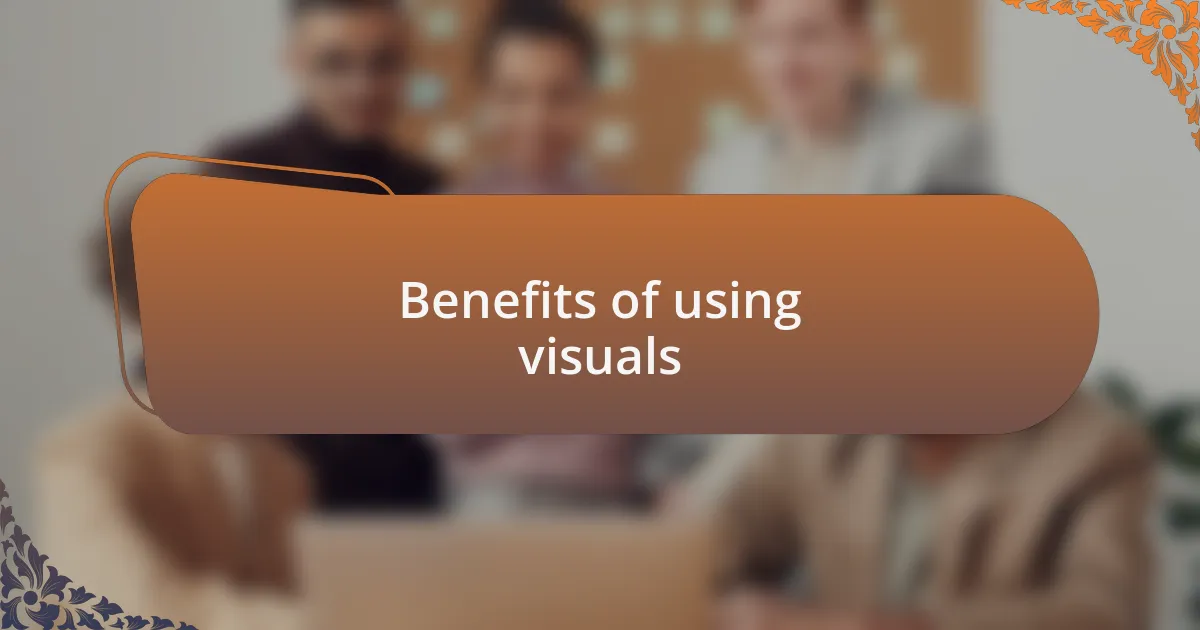
Benefits of using visuals
When I incorporate visuals in my discussions about selective mutism, I notice a remarkable shift in engagement. For instance, during a recent workshop, I used visual aids that featured different emotions illustrated through simple icons. The kids responded immediately, pointing out their feelings in a way that words alone simply couldn’t achieve. Isn’t it heartwarming to witness such a breakthrough?
Another aspect I’ve observed is that visuals can significantly reduce anxiety. Children with selective mutism often feel overwhelmed in social settings, but when visuals are introduced, they serve as a calming anchor. I remember a case where a young girl used pictorial schedules to express her daily routine, which eased her stress tremendously. How empowering is it to give children the tools they need to navigate their world?
Moreover, visuals can enhance collaboration between caregivers and children. I’ve seen parents use illustrated charts to facilitate conversations about feelings, making it easier for their children to open up. This shared visual language not only strengthens connections but also fosters a sense of unity. Have you noticed how visuals can create a safe space for expression, allowing even the quietest voices to be heard?
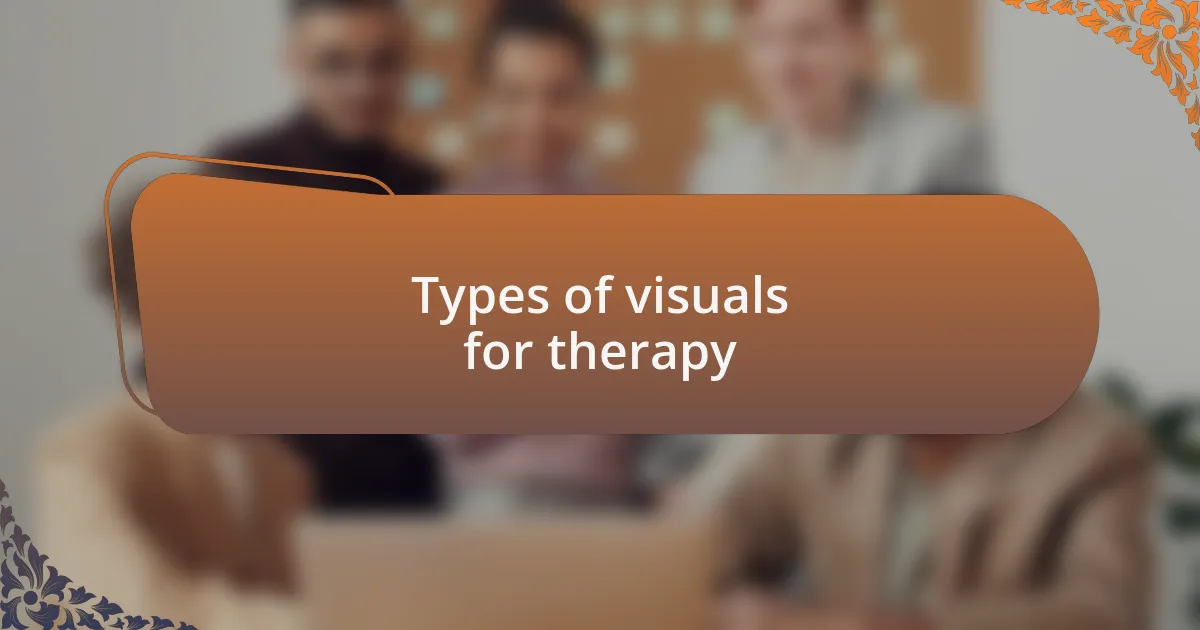
Types of visuals for therapy
When exploring types of visuals for therapy, I often find that storyboards can be incredibly effective. In one session, I introduced a storyboard that depicted a child’s day, leading to productive discussions about social interactions and challenges. Have you ever noticed how stories can help make abstract ideas more relatable, especially for children who struggle with verbal communication?
Another valuable type of visual is the use of visual scripts. I recall working with a young boy who was hesitant to approach peers during playtime. By creating a simple visual script with images of actions and phrases, he gradually felt more equipped to join in. It’s fascinating how structured visuals can provide step-by-step guidance, offering children the confidence they need to navigate tricky social waters.
Additionally, I’ve found that using visual emotion cards can be a game-changer in therapy sessions. I remember an instance where a group of children shared their feelings using these cards during a group activity. The transformation in their ability to articulate emotions was remarkable. Isn’t it amazing how something as simple as cards can unlock a child’s emotional expression and enhance communication?
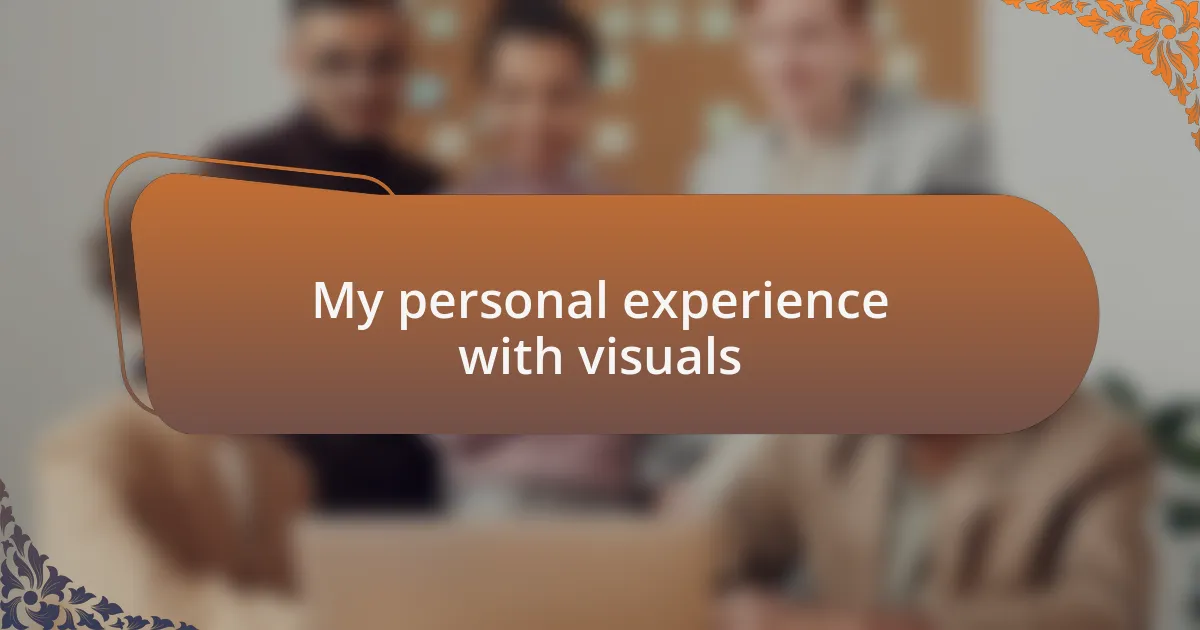
My personal experience with visuals
I have often turned to visuals in my own practice, finding that they create a bridge between emotion and expression. One day, I used a chart depicting various scenarios a child might face in school—like raising a hand or joining a group project. The moment I saw the child’s eyes light up as they identified with an image of another student raising their hand, it struck me how visuals can resonate on a deeply personal level.
In another instance, I experimented with highlighting emotions through visuals. When I introduced a set of drawings showing different facial expressions, I watched as a young girl pointed to the one that represented how she felt in challenging situations. She articulated that seeing the image allowed her to connect her feelings to something tangible. Have you ever considered how powerful a simple illustration can be in unlocking feelings that words sometimes cannot express?
Using visuals has often felt like peeling back layers of hesitation. I vividly remember a session where I employed a visual journaling technique, allowing a child to sketch their thoughts. The awe in their expression when they saw their feelings take form on paper was palpable. I can’t help but wonder, how often do we overlook the ability of visuals to transform understanding and connection in our daily interactions?
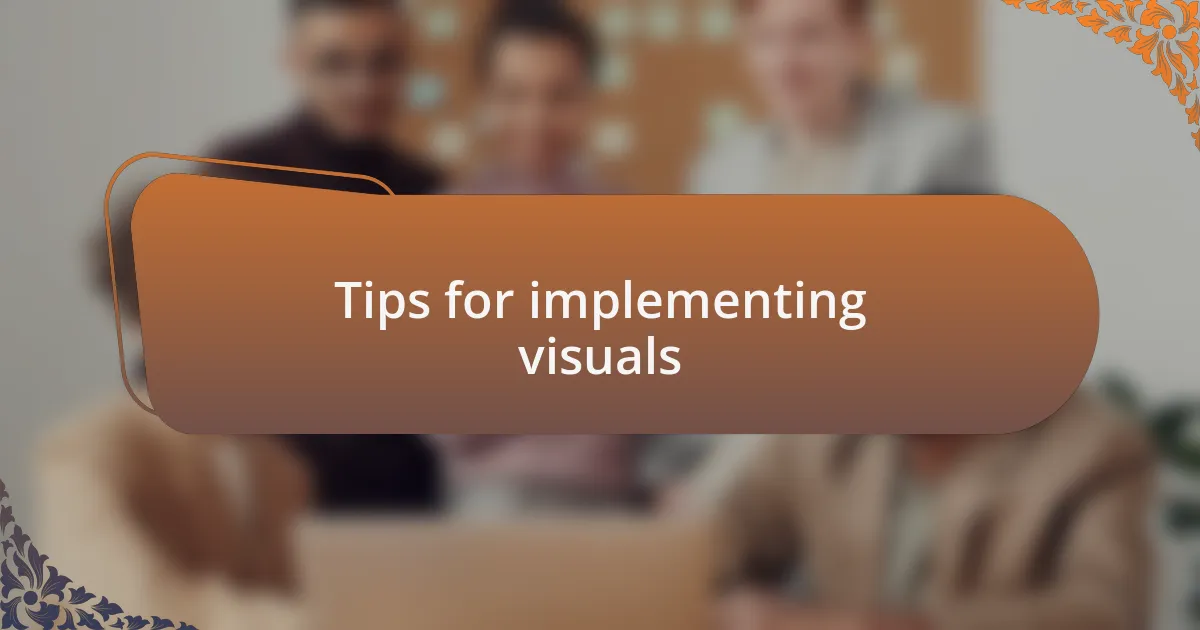
Tips for implementing visuals
When implementing visuals, I often recommend starting small. For instance, using a single, powerful image can convey complex ideas without overwhelming the viewer. I recall a workshop where I introduced a simple infographic illustrating the steps a child could take when feeling anxious. Participants found it easy to relate, and I could see the understanding deepen as they connected visuals with their own experiences.
It’s also crucial to consider diversity in the types of visuals you use. I once created a mood board combining photographs, drawings, and color swatches, tailored to represent various emotions. It was fascinating to watch the participants engage differently with each visual medium. Have you ever noticed how color can evoke an entirely different emotional response? Such variations can enrich the communication experience, especially for those who may struggle with verbal expression.
Lastly, remember to involve the audience in the visual storytelling. Engaging children in the creation process can lead to remarkable insights. During a session on selective mutism, I invited the kids to draw their favorite scenes from school. Their creations sparked conversation, revealing unspoken fears and joys. It’s moments like these that remind me how empowering it is to give a voice through visuals. What types of visuals do you think could spark a similar dialogue in your practice?
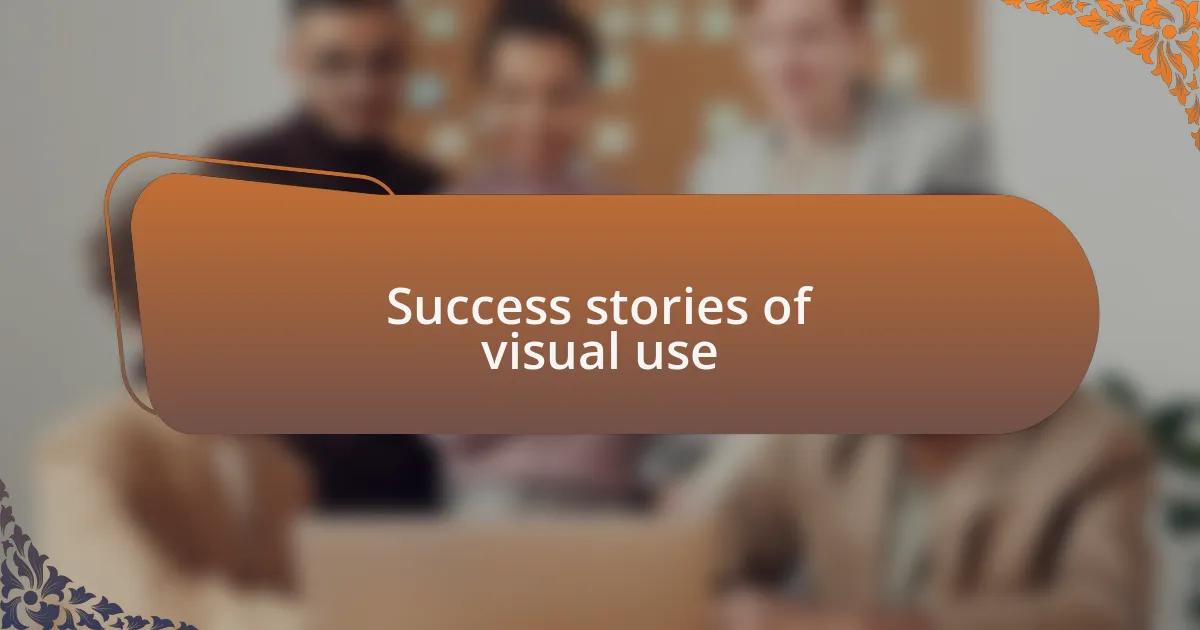
Success stories of visual use
When I think about the success stories of visual use in raising awareness about selective mutism, one instance comes to mind vividly. A colleague of mine implemented a series of animated videos that showcased the daily experiences of a child with selective mutism. The response was heartwarming; not only did parents resonate with the content, but they also shared how it opened up conversations at home. How often do we miss those opportunities for dialogue simply because we lack the right tools?
Another memorable success was when a local support group integrated visual aids, like storyboards, to illustrate coping strategies. Participants described how seeing their fears represented visually helped normalize their experiences. It struck me how visuals can serve as a bridge, connecting people to experiences that feel isolating. Have you ever considered how seeing common scenarios depicted can make one feel less alone?
Lastly, I recall a workshop where we showcased photo diaries created by children expressing their feelings. The impact was profound; through simple visuals, we unlocked discussions that would have otherwise remained silent. Parents were moved to tears as they realized they could potentially validate their children’s feelings just by acknowledging the visual stories before them. Isn’t it incredible how something as straightforward as a photo can lead to such deep emotional connections?